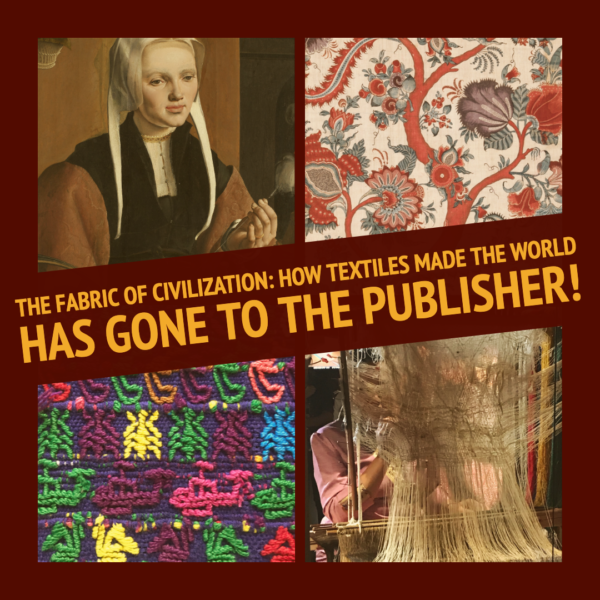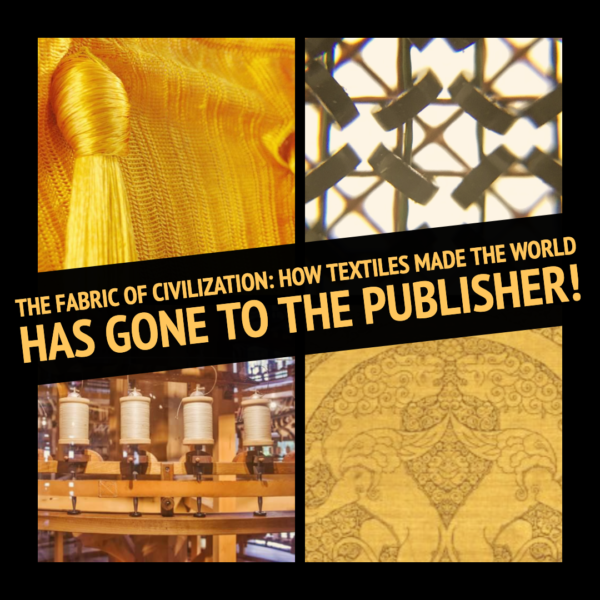THE FABRIC OF CIVILIZATION: HOW TEXTILES MADE THE WORLD Has Gone to the Publisher!
On Sunday, September 29, I turned in the manuscript for my next book, The Fabric of Civilization: How Textiles Made the World, which will be published in November 2020 by Basic Books. It will also come out in the U.K.
I made a couple of collages for my Instagram feed, with pictures hinting at some of the stories I'm eager to share. Here, I'll give a bit more about them.

The top left image, which appears at the beginning of chapter two (Thread), is from a portrait Maerten van Heemskerck painted in 1529 that is now in Amsterdam’s Rijksmuseum. It shows a woman named Anna Codde spinning, an absolutely essential form of labor before the Industrial Revolution. To give you some idea of how essential, consider that the cloth for a single pair of jeans requires about six miles of thread, which could take weeks to spin by hand.
The top right image is an example of a cotton print from India--known as a calico, chintz, or indienne. With their bright, washable colors, these light-weight fabrics were a revelation to Europeans and hugely popular. They also threatened established wool and silk industries, and many countries banned their importation. France was the most extreme, treating printed fabrics the way the U.S. today (or perhaps in the 1980s) treats cocaine. For more on this bizarre story, and a flavor of the book, you can read this article I wrote for Reason. I tell this story in chapter six (Consumers) and discuss the impact of Indian cottons in chapter two (Thread) and dyes in chapter four (Dye).
The bottom right shows the back of a traditional Lao loom, with strings that hold the code for the brocade pattern the weaver is making. (For more on how the pattern is "programmed," see this site.) Contrary to what you may think from reading tech stories about the Jacquard loom, it was not the first technology to record and store weaving codes. By the time Joseph-Marie Jacquard invented his card-driven loom attachment, human
weavers had been imagining, remembering, and recording complex either-or patterns for
thousands of years. His innovation was a mechanical leap forward, automating the process. I delve into the relations between weaving, code, and mathematics ("the science of patterns") in chapter three (Cloth).
Finally, on the bottom left, is a detail from a huipil I bought in Guatemala. The huipil is the traditional blouse worn by Maya women and woven on a backstrap loom. As you can guess from the helicopters incorporated along with traditional patterns, such as scorpions, huipile may be traditional but they are not static. Living traditions never are. I discuss their evolution in chapter six (Consumers). For a thematically related story, which isn't in the book, you can read this Reason column on Chiapas.

The top left photo is a detail from a Stella McCartney dress made for this exhibition at the Museum of Modern Art. The material is bioengineered silk, a "protein polymer" made by Bolt Threads. The raw material is silk protein excreted by bioengineered yeast and fermented like beer. I discuss bioengineered silk, as well as the old-fashioned kind, in chapter one (Fiber).
The top right photo is a 60X magnification of magnetic core memory, the dominant computer storage medium for two decades, until the emergence of silicon memory chips in the early 1970s. The form of the memory devices arose from the fundamental mathematics of weaving. I discuss core memory and visit textile artist Robin Kang, whose work evokes it, in chapter three (Cloth).
The bottom right is a detail of Mongol cloth of gold now in the Cleveland Museum of Art. Combining Iranian motifs of griffins and winged lions with Chinese cloud patterns on the lions’ wings, it illustrates the hybrid motifs and techniques that emerged from the Mongols' imperial workshops. A nomadic culture of felt and fur, the Mongols loved woven textiles, especially those incorporating gold threads, and the desire for such treasures motivated many of their conquests. I discuss the Mongols inn chapter six (Consumers).
The bottom left is a detail from the most amazing thing I saw, among many amazing things, during my textile research: a two-story hydraulic machine, built almost entirely of wood, for twisting ("throwing") silk filaments. These are not, as you might imagine, 18th- or 19th-century inventions. They date back to the 15th century and had their heyday in the 16th and 17th centuries (although this particular one operated up until the 1930s). Flavio Crippa, a physicist who spent his career developing machines for the modern silk industry, has for the past couple of decades worked to recover, restore, and re-create them for museums throughout Italy. I was lucky enough to have him as a host on a tour of several museums, including the one in Caraglio that I visit in chapter two (Thread). Here's a video to go with the photo: